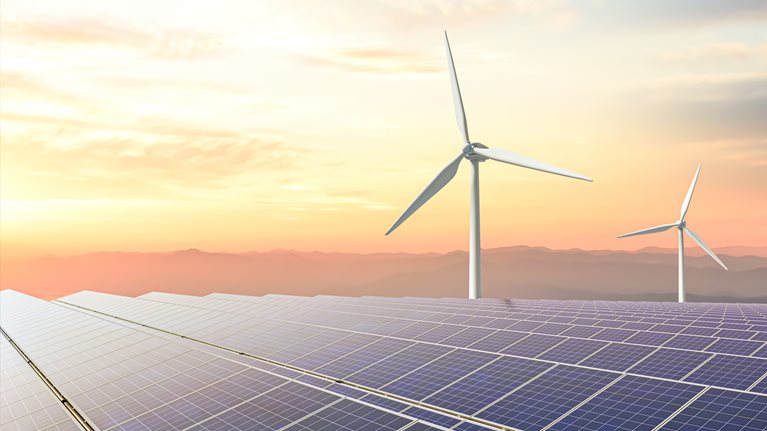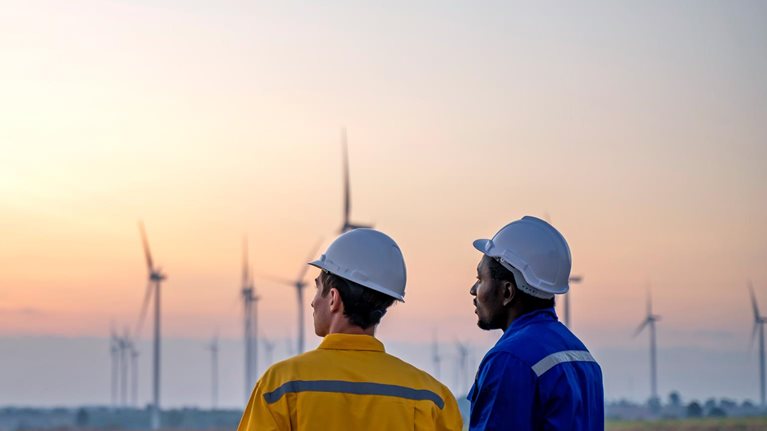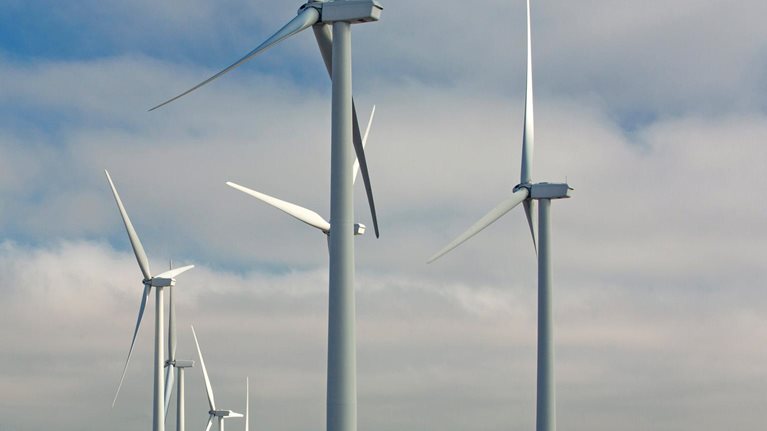As countries around the world work to meet aggressive decarbonization goals, energy from wind and solar sources are a beacon of hope. Carbon-free, inherently abundant, and increasingly affordable, these renewable sources remain a vital pathway to achieving global net-zero carbon emissions by 2050.
McKinsey estimates that between 2021 and 2030, planned global electricity generation from committed solar and on- and offshore wind projects (excluding China) will more than triple, from 125 gigawatts to 459 gigawatts (Exhibit 1).1 This could further accelerate as countries seek to make renewables part of their strategy to address the current geopolitical energy crisis. The European Commission’s recent REPowerEU proposal, for instance, seeks to boost the continent’s share of electricity generation from renewables to 45 percent by 2030 (up from a target of 40 percent).2 In the United States, the Inflation Reduction Act, which provides a comprehensive package of financial incentives for renewable-energy development, could also stimulate additional wind and solar capacity.3

Such rapid growth requires stable markets and resilient supply chains. In recent years, renewables markets have experienced high volatility because of fluctuations in the supply and prices of raw materials, as well as frequent changes in regulations (Exhibit 2). This lack of continuity has made long-term capacity planning and the practice of securing favorable prices for large quantities of raw materials very difficult.

In Japan, for instance, the offshore wind market is currently on pause as the Japanese government revises its rules for auctions of offshore wind permits. Additionally, Danish wind turbine manufacturer Vestas canceled plans to build a turbine production facility in Nagasaki after it failed to receive orders from the winners of a previous offshore wind auction.4
Prices for the materials needed to create wind turbines and solar panels have also experienced significant volatility. The COVID-19 pandemic revealed the extent to which global supply chains are vulnerable to local and regional disturbances. Consider the supply of polysilicon, the starting material for wafers in solar cells. In China, which produces more than 79 percent of the world’s supply (as of 2020), COVID-19 lockdowns, factory accidents, and floods have sharply reduced availability. Between 2020 and June 2022, the price of polysilicon rose by 350 percent.5
Cost inflation has also affected commodities needed for wind turbines. Due to the combination of rising global demand for wind energy and pandemic-related supply issues, the prices of steel, copper, and aluminum have experienced two- and threefold increases over the past few years. Earlier this year, disruptions due to the Ukraine crisis exacerbated the problem. Because price hedging in raw-materials purchasing is not a widespread practice, the wind industry has felt the squeeze. Turbines are 40–50 percent steel (used for towers, structure, and mechanical components), copper (generator winding and cables), and aluminum (nacelle). Leading turbine manufacturers and cable suppliers have tried to pass the increased costs of these materials on to their customers.6 However, several have issued profitability warnings, in part because some of their long-term contracts with customers contain fixed prices that do not allow adjustments.
Renewables developers face three core supply chain challenges
In today’s volatile conditions, renewables developers and OEMs will have to tackle several challenges in order to mitigate risk and build a more resilient supply chain.
Securing access to raw materials and rare earth metals at stable prices
The commodity squeeze challenging the wind and solar industries will only get tighter as demand increases from global decarbonization efforts. The rare earth metals neodymium and praseodymium, for example, are needed as high-power magnets in both wind turbine generators and electric vehicles. Yet McKinsey estimates that these materials will face a 50–60 percent shortage in 2030.7 Recycling will play an increasingly important role but is expected to meet only 10 percent of total demand.
Green steel offers another example. Environmental, social, and governance (ESG) requirements are driving up wind and solar industries’ interest in steel produced with minimal or zero CO2. But ramping up production of steel with hydrogen instead of fossil fuels faces multiple hurdles. The construction of new large-scale facilities often involves lengthy efforts to obtain subsidies and to design and develop unique equipment. In parallel, steel producers have to install capital-intensive electrolyzers or secure hydrogen supply through (long-term) contracts. On top of that, significant infrastructure developments are required, such as the construction of a network of pipelines to transport large quantities of H2.
Scaling manufacturing capacity to meet regional demand
The growing demand for renewables has been pushing up factory utilization rates in the industry. Unless additional capacity is added, this can make supply chains more vulnerable to unplanned events. The COVID-19 lockdowns, factory accidents, and floods that affected poly-silicon manufacturing, for instance, have helped increase capacity utilization rates to 100–110 percent since 2020, causing shortages and price hikes.8 Across renewables supply chains, extensive investments are needed to grow capacities in line with demand and avoid large-scale imbalances between supply and demand.
In addition, the dominance of one region and the relatively small number of suppliers weaken the resilience of renewables supply chains. In the case of polysilicon, 79 percent of global capacity is located in China, and half of that is concentrated in the province of Xinjiang, making wind and solar players across the globe especially vulnerable to disruptions in this area. Additionally, the top ten suppliers of polysilicon, only three of which are outside China, have a total capacity of more than 90 percent of global capacity (Exhibit 3). The fact that many of these suppliers have announced capacity expansions in recent years will likely only boost their share of the market.

Building up logistics and installation capacities
The installation of new wind and solar capacity is going to require a lot of talent and a lot of machinery. Yet developers often face a shortage of both. Over the past two years in the United States, for example, qualified engineering, procurement, and construction (EPC) capacity for large-scale, one-gigawatt-plus solar plants has faced a gap of about one to two gigawatts per year.9 Unable to hire enough talent, EPC contractors have been bidding selectively on fewer projects, which has eroded competition and increased prices for developers. Instead of the usual six to eight bids for projects, many developers are receiving one at a higher price. EPC contractors have grown their margins, while solar developers have had theirs squeezed.
Another area of limited capacity is the vessels used to install offshore wind turbines. Although the wind turbines for large offshore projects have gotten bigger, a limited number of vessels have been upgraded for the task of transporting and installing them. In 2020, the Global Wind Energy Council identified a total of only nine large-scale (more than ten megawatts) turbine vessels.10 The companies in a position to add this urgently needed capacity are limited to a small circle of established players. Only three companies plan to own more than three heavy lift and jack-up installation vessels.
Considering that the construction of one vessel takes several years, and vessel capacity will likely need to double to build twice as many offshore wind projects in 2025, this poses a real threat to the 20 offshore wind farms, representing a capacity of 42 gigawatts, that have already passed the final investment decision stage.12
How to make sourcing a strategic priority
In order to build resilient supply chains and thus achieve ambitious expansion targets, sourcing needs to become a strategic priority. While there are a wide range of approaches and solutions, we see three key success areas.
Getting creative with vertical integration
Long-term partnerships, targeted acquisitions, and shareholder agreements can be critical levers for securing raw materials and decreasing the price volatility of key components. The electric-vehicle-battery industry offers a potential road map. Tesla forged a parts-purchasing agreement with the Chinese neodymium magnets manufacturer JL MAG in 2020 and struck a long-term agreement to buy nickel from the Brazilian mining company Vale SA earlier this year. The company has also announced deals with mining companies in China and the Democratic Republic of the Congo for cobalt and lithium. These arrangements promise to give Tesla a steady supply of some of the highest-demand raw materials needed for electric vehicles. At the Financial Times’ 2022 Future of the Car conference, CEO Elon Musk summarized the strategy: “It’s not that we wish to buy mining companies, but if that’s the only way to accelerate the transition, then we will do that.”13
In the renewables sector, Ørsted, the multinational Danish power company and the world’s largest developer of offshore wind, has pioneered a similar approach. In a strategic partnership with German steel producer Salzgitter AG, announced in early 2022, Ørsted will supply the hydrogen and zero-carbon electricity (from wind) that Salzgitter needs to produce green steel, which Ørsted will then purchase for its wind turbines. In addition, scrap from decommissioned Ørsted wind turbines will cycle back to Salzgitter’s steel production process. This arrangement not only reduces resource consumption and promotes circular-economy principles but also reduces the need for green-steel production capacity, thus helping to ease pressure on the supply chain.14
Partnering with suppliers to boost manufacturing capacity
Given the vulnerability of global supply chains, renewables developers may benefit from partnering with their suppliers to build additional manufacturing capacity. This could include the insourcing of critical components, the expansion of manufacturing facilities, or the creation of new facilities.
In many countries, governments are eager to help in this effort and have created policies and incentives that seek to promote clean-energy manufacturing within their borders. For example, in 2022, Italian utility Enel pursued both these options in an effort to support the growth of the national renewable-energy supply chain in Italy. The company announced a 15-fold increase in its production of bifacial photovoltaic modules at its factory in Sicily, from 200 megawatts per year to three gigawatts per year by 2024.15 In addition, Enel entered into a strategic partnership in 2022 with engineering firm Comal to build a factory for the production of solar trackers, which direct solar panels toward the sun.
This facility will support up to one gigawatt per year of photovoltaic-energy production with all-Italian tracking systems.16 Similarly, in the United States, the Inflation Reduction Act seeks to support the growth of a national renewable-energy supply chain. It allocates an estimated $30 billion in production tax credits to accelerate US manufacturing of solar panels, wind turbines, batteries, and critical-minerals processing.17
Making risk management a common practice
Tools such as price hedging and long-term agreements that secure the cost of raw materials such as steel can significantly mitigate the effects of sharp price increases. The fact that wind and solar suppliers were caught off guard by the recent increases indicates that risk management capabilities are not sufficiently developed among renewable-energy OEMs. Developers should work with their suppliers to jointly invest in upskilling employees in risk identification and price hedging for raw-material purchases. This will be particularly important when suppliers are committing to long-term offtake agreements. Risks and appropriate countermeasures will need to be integrated into the design of these partnerships.
For developers, early and proactive risk identification should become an important part of the evaluation and management of suppliers, with consideration given to future capacity constraints, price volatility, and access to raw materials and rare earths even before a supplier is awarded with a contract. In particular, access to rare earths could be established as a bidding criterion. Among OEMs, initiatives to secure access to raw materials are a point of differentiation rather than an industry-wide standard.
While many industries are struggling with supply chain issues, those with a forecast of rapidly increasing demand face particular challenges. Early development of creative strategic measures is critical. With a focus on vertical integration, strategic diversification, and proactive risk management, renewables developers can prepare for the challenges ahead.


